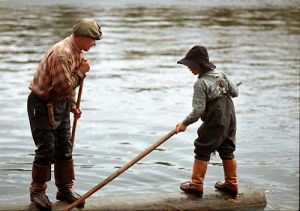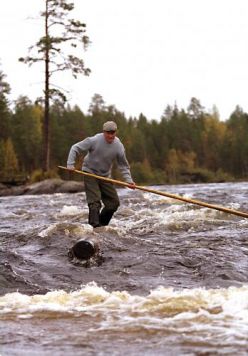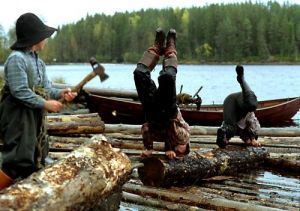Timber rafting tradition
| Timber rafting tradition | ||||
|---|---|---|---|---|
| In the national inventory | ||||
|
Practitioners and people who know the tradition well

People have moved and transported heavy goods through waterways everywhere. The Bible even tells the story of how the construction timber for Solomon's Temple was floated from the forests of Lebanon to the construction site. The tradition of timber rafting or log driving (known as "uitto" in Finnish) gathers, preserves, and shares the skills and methods for transporting timber from remote areas to its intended use locations. The need for transporting construction timber is one of the earliest forms of log driving. In Finland, timber for sawmills was obtained from the upper reaches of rivers by floating it downstream. As log rafting methods developed, larger quantities of timber could be transported over longer distances, leading to the growth of the forestry industry. Different water bodies, such as streams, rivers, lakes, and seas, required different log driving methods, and mechanization further transformed log driving.
Forestry and log driving provided employment and income in rural areas all across Finland. During the winter, felled trees were transported by horses to the water's edge. Once the waterways thawed, the logs stored in the upper reaches of the water were floated down, assembled into larger rafts, and then typically towed to their intended destinations. These towing operations were carried out collectively, with all log drivers on the river or lakes working together to combine their timber. Each log driver would retrieve the logs marked with their own distinctive marks at downstream sorting points. Rules and regulations detailing how log driving was to be conducted were established and varied by watershed regions.
Organizations such as the Suomen Uittoperinneyhdistys ry, Pielisen-Karjalan Tukkilaiset ry, Evijärviseura ry, Pirkka-Hämeen Jätkäperinneyhdistys ry have been established to preserve log driving traditions. Additionally, many village associations showcase log driving and lumberjack skills to the public during their summer events. There are hundreds of log driving enthusiasts in Finland. The Finnish Log Driving Heritage Association's Facebook group has gained over 330 members in just a couple of years, with monthly visitor numbers reaching over two thousand. Membership numbers for these associations have remained stable, with new enthusiasts joining as older members leave.
Punkaharju's Lusto, Lapland Forest Museum in Rovaniemi, and Pielinen Museum in Lieksa have comprehensively collected this cultural heritage in their collections. There are also private museums, such as Mäntyharju's Miekankoski and Heinävesi's Palokki. Local heritage museums often have interesting collections showcasing log driving in their respective areas. Across Finland, log driving heritage has been honored with monuments.
In the Vuoksi watershed, the Järvi-Suomen Uittoyhdistys still practices log driving. In other watersheds, log driving has ended. Timber harvested from island forests is transported to
its destination by floating it through waterways. Push barge transportation has become a popular supplementary method. Bunch log driving is an economical and ecological means of transport for long distances when large quantities of timber need to be floated. The number of log drivers is increasing, and most forestry companies are interested in log driving and the log driving heritage. The Suomen Uittoperinneyhdistys’s supporting membership has grown from around five to over ten in just a few years.

Practising of the tradition
Timber is transported by water. The era of brook driving ended in the 1960s, but logs have been floated for display purposes via log slides. Timberjack shows and competitions showcase various skills required during log sliding. Logs travel with the current, and their movement is aided by dams that collect water for log sliding and guide them with otvils, which were logs attached to the shore to prevent the logs from getting caught on the shore and rocks. As log sliding progressed to larger bodies of water, the timber was assembled into rafts. Log transport was made more efficient by bundling the timber, which was then towed to sorting locations or end-use sites. At sorting locations, each log driver would collect their logs marked with their unique marks. Every log driver had their own mark stamped onto the ends of the logs. Early on, log hauling was done with timber boats or punts. These boats had anchor ropes wound around the log, either manually or with the help of horses. The raft was first moved further away, and then the raft attached by the hauling rope would be pulled. When motorboats became available, hauling shifted to mechanized methods.
The practice of log driving heritage involves demonstrating and showcasing lumberjack and log driving skills during summer events and competitions. In northern rivers, log rafts were also used, consisting of multiple logs bound together with wooden clamps. The raft had several log bundles in a row and was steered using long paddles attached to the bow and stern. A traditional raft was built and floated down to Tornio in Pello. The construction of the raft and the log driving route have been documented on video. Rafting has also taken place on the Iijoki River, where these rafts were used to transport tar barrels in addition to logs. Videos of log driving heritage events have been shared on the internet. Museums have collected equipment, documents, and photographs related to log driving. Work demonstrations have been held in conjunction with exhibitions to showcase log driving heritage.
The Suomen Uittoperinneyhditys ry and the Pielisen-Karjalan Tukkilaiset ry participate in international log driving heritage activities through the International Timber-Raftsmen Association. The organization hosts an annual international log driving event where different countries and water bodies showcase their log driving methods to log driving heritage practitioners. Kuhmo will host the annual meeting in 2024. The organization has identified significant locations based on log driving heritage practices as log driving heritage towns. Long-standing practitioners of log driving heritage are awarded. The organization has advocated for the recognition of cultural heritage by UNESCO. Spain, Germany, Poland, the Czech Republic, Latvia, and Austria jointly proposed log driving heritage for UNESCO's List of Intangible Cultural Heritage. During the UNESCO Intergovernmental Meeting in Rabat, Morocco, on December 2, 2022, it was acknowledged that Timber Rafting is living human cultural heritage.
Suomen Uittoperinneyhdistys ry has published "Vonkamies" for 26 years. This publication has shared memories and events related to log driving. It has recounted developments in
log driving and analyzed their causes and consequences. For the past couple of years, log driving heritage practitioners have had their own Facebook group, and the association has established a website. The internet has facilitated cooperation among log driving heritage practitioners both within Finland and internationally.
The background and history of the tradition
Finland's forest industry originated along the log driving routes because it was initially the only feasible means of transporting large quantities of timber. Sawmills were established near rivers as early as the 1600s, and they also engaged in export trade. Steam power in the late 1800s enabled the expansion of sawmill operations. Concurrently, log driving methods suitable for long-distance transport were developed. For instance, the UNESCO World Heritage Site Verla was situated at the mouth of a major water route. Wood pulp mills and sawmills were constructed near the mouths of rivers along the coastline. In addition to sawing large logs, smaller-diameter timber was also utilized. Large pulp, paper, and plywood mills were likewise designed along water routes. Until the 1960s, log driving was the primary mode of transportation. Road and railway transport developed and increased their share of raw material deliveries. Log driving faced challenges due to its capital intensity, and although log driving methods became more mechanized, a significant amount of manual labor was required. Concurrent use of timber for land transport and log driving at sawmills caused problems, and standing timber in log storage areas added to quality variations. Push barge transport became common in waterway transport. As a fast mode of transport, it is suitable for various types of cargo. Nevertheless, bundle log driving has maintained a competitive edge in cost-effectiveness for long-distance transport. Up to 400 truckloads of timber can be attached to a single bundle raft.
The transmission of the tradition

Suomen Uittoperinneyhdistys ry, Pielisen-Karjalan Tukkilaiset ry, Evijärviseura ry and Pirkka-Hämeen Jätkäperinneyhdistys ry have been established to preserve old log driving traditions. Many village associations also engage in this cultural heritage, passing down knowledge and skills to new generations. New material about log driving has been documented for schools. Excursions explaining log driving have been organized for schoolchildren. Websites and the Suomen Uittoperinneyhdistys’s Facebook group provide information to enthusiasts and those interested in log driving. Summer events and loggers' competitions are more traditional ways of passing on the tradition.
In addition to annual events like the Käylä Loggers' Weekend and the Loggers' Finnish Championship, occasional events have been organized in places such as Evijärvi, Iijoki, Kuhmo, Torniojoki, Lieksa and Kuopio. Weekly performances have been organized in Lieksa, Kuopio, and Evijärvi during the summer, where newcomers are guided in log-driving skills. Through these associations, it is also possible to request professional demonstrations.
Log driving has been part of the curriculum in forestry schools. The Järvi-Pohjanmaa adult education center has offered courses where log-driving skills can be learned. There are plans to organize events about forest and log-driving history for students. A project managed by the Itä-Lapin kuntayhtymä has produced educational videos about local log driving traditions for schoolchildren. The creation of a virtual log-driving video is in progress. A documentary film about camp cooks is nearing completion. It tells the story of how food supply was organized during large logging and log-driving operations in the wilderness of Finland.
Passing on the tradition through the internet is fast and efficient. With videos, not only knowledge but also skills can be taught to various locations. In the future, creating and sharing content on the internet and through videos will become even more crucial for cultural preservation work.
Safeguarding tradition
Log driving tradition is practiced more collaboratively. Someone from most hobby associations has joined the Facebook group of Suomen Uittoperinneyhdistys. Contact is maintained through the internet via messages or publicly on the website. Videos and photos are shared, and events are announced. As log-driving volumes are increasing, several companies have shown interest in cultural heritage as well. Although funding is a challenge, in recent years, foundations and private and public organizations have provided funding for projects. European Union funding has also been obtained, at least in Lapland. When events attract the public's interest, they also generate income for their activities.
The aging of skilled individuals is a challenge, but young people and women have been brought into the fold.
The biggest threat is the destruction of log driving structures and waterways to the extent that they cannot be used for events. Many log-driving canals and channels built for log driving are at risk of demolition when areas are designated for fishing. Some places must be preserved for the practice of cultural heritage.
How is tradition recorded?
The EU-funded "Introducing the Logging Tradition of Eastern Lapland and Sodankylä" project has arisen from the need to preserve the region's log driving tradition for current and future generations. The documentary film about camp hostesses, funded mainly by foundations and produced by the Suomen Uittoperinneyhdistys, is part of the forest and log culture. Previously, documentaries showcasing logging culture have focused on loggers, lumberjacks, and horse-drawn transport. Now, the surviving camp hostesses reveal how vital food supply was organized in the wilderness during logging and log driving operations. The interviews are archived at the Forest Museum Lusto.
Logging traditions continue to be documented in museums, primarily at Lusto but also at other museums..
The future of the tradition
IIn a changing world, log driving and, through it, the logging tradition have become more important. Older generations have personal experiences with log driving, but young people lack a connection to it. According to a survey conducted among schoolchildren, only a few can describe log driving. Just a few decades ago, log driving was the first paying job for many. At its peak, log driving reached 16 million cubic meters per year, practiced throughout Finland. In recent years, only the Vuoksi water system has seen log driving, varying between 0.5-1.0 million cubic meters per year. The same amount has been transported annually using push barges. With rising fuel prices and the cessation of wood imports from Russia, interest in log driving has increased. Most companies are exploring ways to save costs through log driving.
Today, log driving has become mechanized work, offering fewer job opportunities than before. Knowledge and skills in log driving are possessed by fewer individuals. There is a
demand for logging traditions. The romance of loggers still appeals to people. Logger skills are becoming a fitness activity. Museum exhibitions and log driving demonstrations continue to interest the public. In recent years, videos about the tradition have been produced and shared online. These newer methods are crucial for preserving and sharing memories of log driving traditions.
As the significance of log driving has increased for various reasons, interest in logging traditions is also on the rise. Support and funding have been found for events and documentary projects, and the public has discovered these activities. However, securing funding for heritage work remains challenging. Nevertheless, the EU Leader funding received by the "Introducing the Logging Tradition of Eastern Lapland and Sodankylä" project provides hope for other cultural heritage enthusiasts as well
The community/communities behind this submission
Suomen uittoperinneyhdistys ry
Pielisen-Karjalan tukkilaisyhdistys ry
Evijärviseura ry
Pirkka-Hämeen Jätkäperinne ry
Itä-Lapin ja Sodankylän uittoperinne tutuksi-hanke Lauri Sneliman, projektipäällikkö
Iijoen tukkilautta näytöslaskut, Jarmo Alasiurua vetäjä
Juhani Hakkarainen, Suomen Uittoperinneyhdistys ry:n puheenjohtaja
Bibliography and links to external sources of information
Online sources
Suomen Uittoperinneyhdistys ry
Evijärviseura.ry-Pohjanmaan Järviseudun Uittomieskämppä
YLE Uutiset: Akrobatiaa tukin päällä koskessa
Suomen Uittoperinneyhdistys facebook-ryhmä
TAPAHTUMAT.LUONTOON.FI Uittovideoita ja muisteluksia
ITÄ-LAPIN JA SODANKYLÄN UITTOPERINNETUTUKSI-HANKE
Videos
Youtube: Miekankosken Uittoperinnepäivä 2018
Youtube: Varistaipaleen kanava - Naiset nipunlaskussa
Youtube: UITTO Nordic Board Company
Yle Areena: Tukkilaiset tulikokeessa
Elävä muisti: Vuoden 1949 ensimmäiset valtakunnalliset tukkilaiskisat
Bibliography
Pakkanen Esko. Ankravee! Kirja uitosta. Metsäkustannus 2015.
Pakkanen Esko: Antaa pölkyn juosta, Pieni kirja uitosta. Suomen metsämuseo LUSTO, Suomen Uittajainyhdistys ry. 2004
Purhonen Elias J. Purhonen: Hivakka, eli selonteko uitosta ja sen terminologiasta. 1998
Kalle Päätalon Iijoki-sarja.
Vonkamies julkaisu.
Tunnettuja elokuvia uittoon liittyen: mm. Laulu tulipunaisesta kukasta, Koskenlaskijan morsian, Tukkipojan morsian, Hornankoski, Kaksi vanhaa tukkijätkää, On lautalla pienoinen kahvila, Tukkijoella, Koskenkylän laulu, Me tulemme taas ja Tukkijoella tapahtuu.
Kattavimmat uittoon liittyvät kokoelmat: Metsämuseo Lusto, Lapin metsämuseo ja Pielisen museo.
